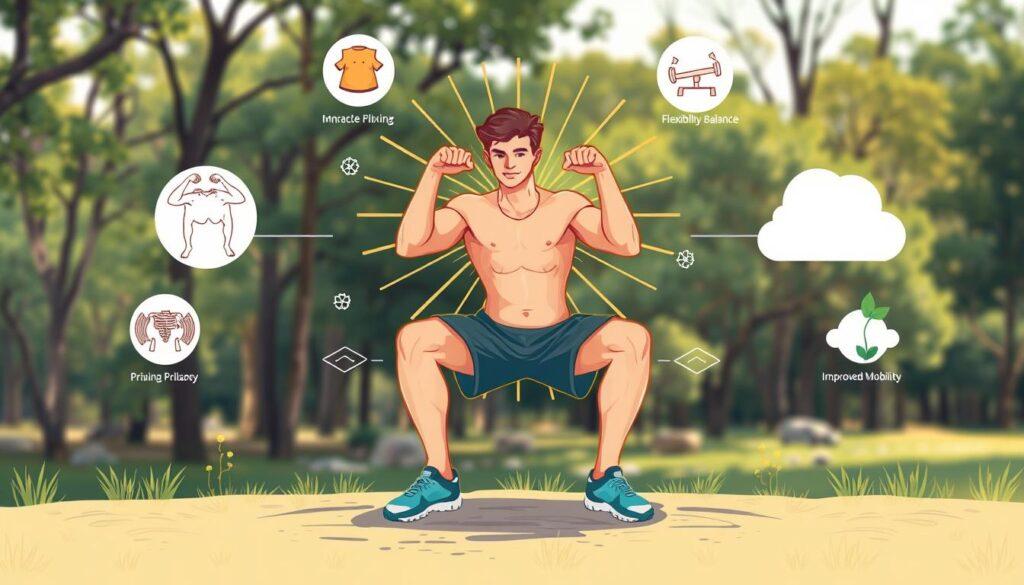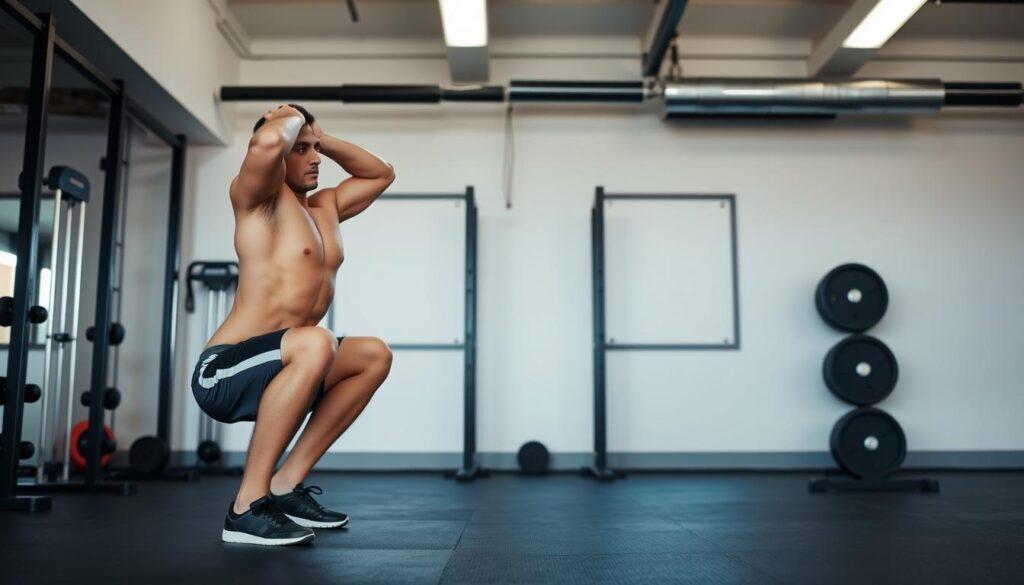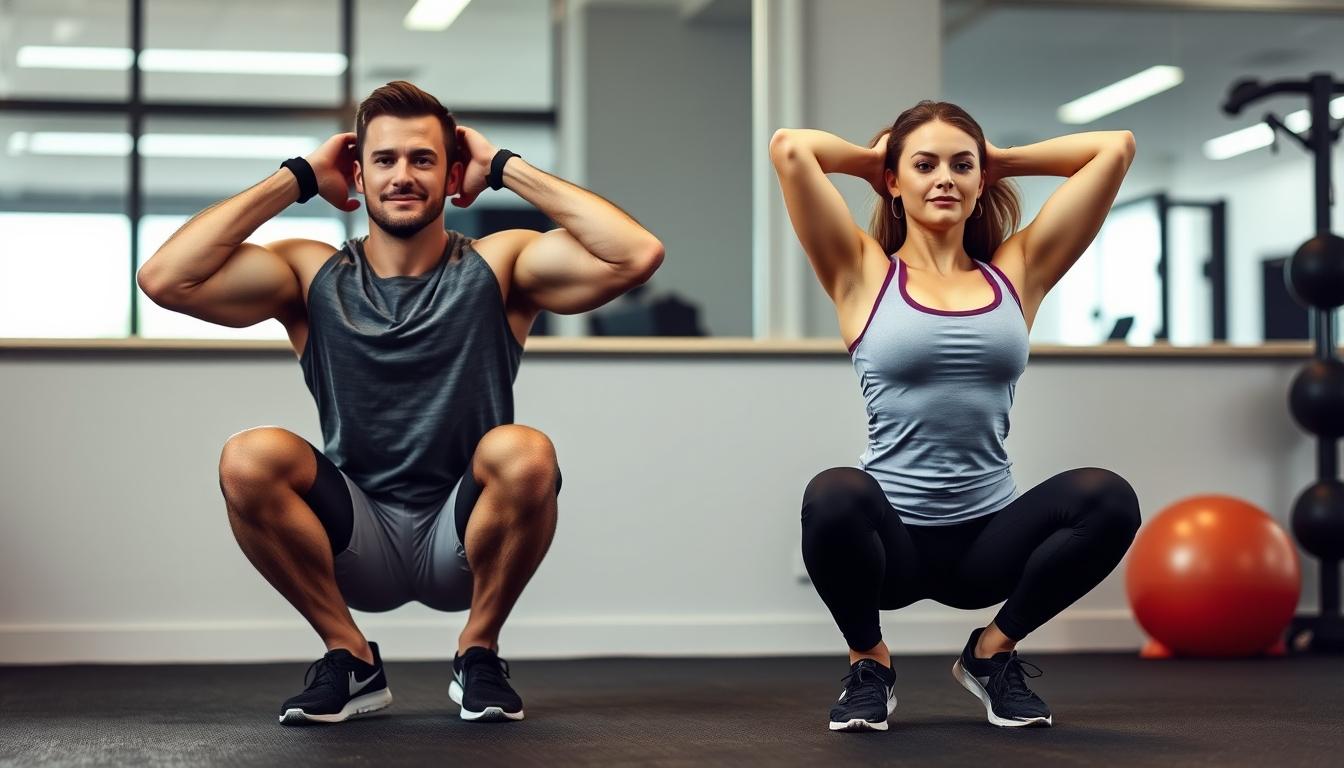The Prisoner Squats Workout is a great way to get stronger and more flexible. You don’t need any special equipment. It’s perfect for working out at home.
Are you looking to add more leg exercises to your calisthenics lower body workout? Then this variation of the traditional squat is a nice addition.
Even though it is similar to a regular squat, having your hands behind your head while performing the prisoner squat, places extra emphasis on your posture helping you keep yourself more upright. With this squat, you will only be using your bodyweight as resistance.
In this article, we will discuss more about the prisoner squat, how to do it correctly and a workout routine that you can use in your calisthenics program.
Doing prisoner squats helps you get stronger. It also makes you more balanced and mobile. This article will show you how to do it right and how to make it easier if you’re not as fit.
Key Takeaways
- Prisoner squats are an effective way to build strength and enhance flexibility.
- This workout requires no equipment, ideal for home exercises.
- Incorporating prisoner squats into your routine can improve balance.
- Understanding proper form is essential for optimal results.
- Variations of prisoner squats can cater to varied fitness levels.
Download The 28 Day Calisthenics Challenge PDF
Enter your name and email to get access to the 28-day calisthenics workout that you can follow.
Introduction to Bodyweight Exercises
Bodyweight exercises are great for getting stronger, more flexible, and enduring. You don’t need fancy gear or a gym to do them. This makes them perfect for anyone, no matter their fitness level.
Benefits of Bodyweight Training
Bodyweight training has many benefits. Here are some:
- Improved muscle tone: Regular workouts make muscles look better.
- Increased flexibility: Many exercises help keep joints and muscles flexible.
- Enhanced overall fitness: It boosts heart health and metabolism.
- Convenience: You can do them anywhere, fitting easily into your day.
Why Choose Bodyweight for Home Workouts
Bodyweight exercises are awesome for home workouts. They need little space, so you can do them anywhere at home. They’re quick, perfect for busy people.
Since you can set your own pace, it’s easy to keep up with. Sticking to a routine can really improve your health and happiness.
Understanding the Prisoner Squats Workout
The prisoner squats workout is a great way to get strong and flexible. It focuses on the right way to do the exercise to avoid getting hurt.
Definition and Technique of Prisoner Squats
The prisoner squat has your hands behind your head. This helps your core work harder. It keeps your body stable during the squat.
To do it right, remember these steps:
- Keep your back straight.
- Lower your hips like you’re sitting in a chair.
- Make sure your knees don’t go past your toes.
By following these steps, you can do prisoner squats safely and well.
Muscle Groups Targeted by Prisoner Squats
This exercise works many muscles in your lower body. It’s a full workout for your legs. The main muscles it targets are:
| Muscle Group | Primary Function |
|---|---|
| Quadriceps | Extending the knee |
| Hamstrings | Flexing the knee and extending the hip |
| Glutes | Hip extension and stabilization |
| Core | Stabilizing the torso and maintaining posture |
Adding prisoner squats to your routine can make your muscles stronger and more balanced.
Benefits of the Prisoner Squats Workout
Adding prisoner squats to your workout routine has many perks. This exercise boosts strength in your lower body. It works on your legs and glutes. It also makes your body more flexible and mobile.
Increased Lower Body Strength
Prisoner squats are great for building strong legs and glutes. They help you move better in sports and daily life. This is because they make your muscles stronger.
Enhanced Flexibility and Mobility
Prisoner squats also improve how flexible and mobile you are. They help your hips and knees move fully. Doing this exercise often helps prevent injuries by improving balance and stability.

How to Incorporate Prisoner Squats into Your Fitness Routine
Adding prisoner squats to your routine boosts your lower body strength. It also improves your athletic performance. A good workout plan includes different exercises for the legs.
This mix makes your workouts more effective. It also stops them from getting boring.
Designing a Balanced Lower Body Workout
To make a balanced workout, mix prisoner squats with:
- Lunges
- Bridges
- Calf raises
- Deadlifts
This mix works all leg muscles well. It builds strength and endurance. Make sure each muscle gets enough work to grow evenly.
Scheduling Your Leg Day Workout
Set aside 1-2 days a week for leg workouts. This lets muscles recover and grow. Use prisoner squats to warm up or as a main exercise.
Here’s a weekly leg day plan:
| Day | Exercise | Sets | Reps |
|---|---|---|---|
| Monday | Prisoner Squats | 4 | 10-15 |
| Lunges | 3 | 12-15 | |
| Calf Raises | 3 | 15-20 | |
| Thursday | Bridges | 3 | 12-15 |
| Prisoner Squats | 4 | 10-15 | |
| Deadlifts | 3 | 8-12 |
This plan covers all leg muscles well. It makes sure prisoner squats are key. Following this routine leads to better lower body workouts.
Proper Form and Techniques for Optimal Results
To get the best results from prisoner squats, pay close attention to your technique. Learning the right way to do it makes the exercise better and safer. This part will cover mistakes and how to fix them.
Common Mistakes to Avoid
Knowing the common mistakes in prisoner squats can make you better. Here are some mistakes to avoid:
- Arching the back instead of keeping it straight.
- Knees caving in when you squat.
- Not squatting low enough.
- Rushing through the exercises, leading to bad form.
Tips for Perfecting Your Form
To keep your form right during workouts, follow these tips
- Start slow and control your movements.
- Keep your back straight during the squat.
- Make sure your knees and toes are in line.
- Use your core to help your lower back.
- Practice in front of a mirror or record yourself to check your form.

By following these tips, you’ll aim for the best results and avoid mistakes that slow you down.
Exploring Squat Variations for Advanced Training
Adding squat variations to your workout can really boost your strength. These changes make your exercises more interesting and tough. Modified prisoner squats are great for adding more intensity and working different muscles.
Modified Prisoner Squats
Modified prisoner squats are a top choice for advanced training. Adding a jump at the top can make your heart work harder. This adds to your heart health.
Another cool thing is to add side lunges. This makes your lower body stronger and improves balance and flexibility.
Combining with Other Bodyweight Exercises
Mixing prisoner squats with exercises like push-ups or burpees makes your workouts better. This mix keeps your routine fresh and boosts muscle endurance. It also helps your heart health.
| Exercise | Focus Area | Benefits |
|---|---|---|
| Modified Prisoner Squats | Lower Body | Increased power and endurance |
| Push-Ups | Upper Body | Strengthens chest, shoulders, and triceps |
| Burpees | Full Body | Boosts cardiovascular fitness and strength |
Prisoner Squats as a Home Workout Solution
Prisoner squats are great for home workouts. They don’t need any special equipment. This makes them perfect for a home gym.
Having a dedicated fitness area boosts your motivation. It helps you stay focused during your workouts.
Creating a Home Gym Space
Choose a quiet spot for your home gym. Make sure it’s free from distractions. A mat can make your workouts more comfortable.
You might want some basic gear like resistance bands or dumbbells. Adding motivation posters can inspire you to keep going.
Full-Body At-Home Workouts Featuring Prisoner Squats
Prisoner squats are good for full-body workouts. They strengthen your legs, core, and upper body. This gives you a balanced fitness routine.
You can try different workout styles like HIIT or circuit training. This flexibility helps you get the most out of your time.
Conclusion
The prisoner squats workout is great for any fitness plan. It makes your legs stronger and improves flexibility and balance. Adding it to your routine can make you healthier.
Learning the right way to do prisoner squats is important. Make sure to include them in your plan every week. Trying different versions can make your workouts more fun and challenging.
Prisoner squats are good for everyone, whether you’re new to working out or have been doing it for a long time. They help you get better at fitness and reach your goals.
Frequently Asked Questions
What are the benefits of prisoner squats?
Prisoner squats boost lower body strength and improve flexibility. They also enhance mobility and posture. These exercises target muscles like the quadriceps, hamstrings, glutes, and core. They’re great for all fitness levels, from beginners to advanced athletes.
How do I properly perform a prisoner squat?
Stand with feet shoulder-width apart. Place hands behind your head with elbows out. Keep your chest up.
Lower your body by pushing hips back and bending knees. Make sure knees don’t go past toes. Descend as low as you can, then push through heels to go back up.
Can I incorporate prisoner squats into my home workout routine?
Yes, prisoner squats are perfect for home workouts. They need no equipment. Add them to a lower body or full-body routine to boost your fitness without a gym..
What are some common mistakes to avoid with prisoner squats?
Avoid arching your back and letting knees cave inward. Also, don’t skip the full range of motion. Keep your back straight and knees right to do squats safely and effectively.
How can I modify prisoner squats for more challenge?
Try jump squats or side lunges for more challenge. Mix them with push-ups or mountain climbers for more variety and intensity in your workouts.
How often should I include prisoner squats in my leg day workouts?
Do prisoner squats 1-2 times a week in leg day workouts. Rest well between sessions to let muscles recover and grow stronger.
Do prisoner squats help improve balance and stability?
Yes, doing prisoner squats regularly improves balance and stability. This is key for safe and effective performance of dynamic movements.
